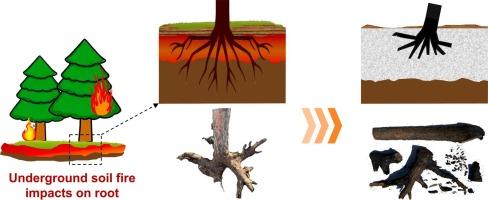地下野火对泥炭土壤植物根系的影响
IF 5.7
1区 农林科学
Q1 GEOSCIENCES, MULTIDISCIPLINARY
引用次数: 0
摘要
泥炭地是重要的陆地生态系统,支持多种植物物种和栖息地。野火对泥炭地生态系统造成了严重的干扰,特别是当地下火灾在泥炭土层中燃烧时。本研究通过综合实验室和田间试验,对植物根系对阴燃泥炭火灾的脆弱性进行了全面调查。在实验室实验中,可控阴燃火焰在含有模拟植物根样的泥炭土上蔓延,即直径为1-5 cm的木棒。在田间试验中,引燃种植落叶松的泥炭土,观察火灾对根系的损害。室内试验表明,当泥炭土含水率低于50%(干质量基)时,在试验范围内,无论根径大小,几乎所有根样在火灾后都烧成灰。当泥炭含水率超过50%时,更大比例的根仍存在不同程度的炭化和质量损失。较薄的根比较厚的根受热更快,损伤更严重。通过将温度和热通量阈值与停留时间联系起来,进一步量化了阴燃泥炭对根部的严重程度,显示出持久的热影响。田间试验成功地揭示了类似的根系炭化和损害模式,随着土壤含水量的增加而减少。此外,地下阴燃火灾还会引发地面火焰,加剧火灾对根系的影响。本研究量化了地下野火对植物根系的损害,并为持续泥炭地火灾的生态影响和缓解策略以及泥炭地保护实践提供了见解。本文章由计算机程序翻译,如有差异,请以英文原文为准。

Impact of underground wildfire on plant roots in peat soil
Peatlands are vital terrestrial ecosystems that support a diverse range of plant species and habitats. Wildfire poses a significant disturbance to the peatland ecosystems, especially when underground fires are burning in the peat soil layer. This study presents a comprehensive investigation on the vulnerability of plant root systems to smoldering peat fires through an integrated laboratory and field experiments. In the lab experiments, controlled smoldering fire spreads over peat soil containing simulated plant root samples, that is, wood sticks with diameters of 1–5 cm. In the field experiments, the peat soil planted with larch trees is ignited to observe fire-induced damage to roots. Laboratory experiments show that, when the peat soil moisture content is below 50 % (dry mass basis), almost all root samples burn to ash after the fire, regardless of root diameter within the test range. As peat moisture content increases above 50 %, a greater proportion of the roots remain with different levels of charring and mass loss. Thinner roots experience faster heating and severer damage than thicker roots. The severity of the smoldering peat fires on root is further quantified by relating temperature and heat flux thresholds to residence time, showing long-lasting thermal impacts. The field experiments successfully reveal similar patterns of root charring and damage, deceasing with the soil moisture content. Furthermore, the underground smoldering fire can also initiate a flaming surface fire to exacerbate the fire impact on the root systems. This study quantifies the damage of underground wildfires on plant roots and provides insights into ecological impact and mitigation strategies of the persistent peatland fire and peatland conservation practices.
求助全文
通过发布文献求助,成功后即可免费获取论文全文。
去求助
来源期刊

Catena
环境科学-地球科学综合
CiteScore
10.50
自引率
9.70%
发文量
816
审稿时长
54 days
期刊介绍:
Catena publishes papers describing original field and laboratory investigations and reviews on geoecology and landscape evolution with emphasis on interdisciplinary aspects of soil science, hydrology and geomorphology. It aims to disseminate new knowledge and foster better understanding of the physical environment, of evolutionary sequences that have resulted in past and current landscapes, and of the natural processes that are likely to determine the fate of our terrestrial environment.
Papers within any one of the above topics are welcome provided they are of sufficiently wide interest and relevance.
 求助内容:
求助内容: 应助结果提醒方式:
应助结果提醒方式:


